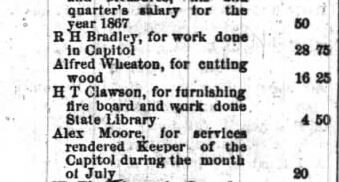
Alfred Wheaton was born around 1807. Though we don’t know much about his early life, we know at some point Alfred married his wife Olive Wheaton. In the 1834 Report of the Commissioners appointed to superintend the re-building of the State Capitol, he was listed as a “laborer.” His work generated $.50 per day. Alfred did not keep that money; we have documentation that shows his enslaver wishing to use the money he made. Most enslaved people were not able to retain the money their labor generated.
We know Alfred worked at the Capitol from 1834 until at least 1838. A letter in the State Capitol Construction Records from that year shows Alfred’s enslaver “M.R. Wheaton” or Mary Wheaton requesting payment from the Capitol project for Alfred’s labor. She requested her “negroes wages,” saying she wishes to “pay some away today.” (For more on the topic of women enslavers)
Mary Wheaton was born around 1787. By the 1830s, she was an enslaver – her husband died in 1832 and she inherited his property. Alfred probably walked to the Capitol’s construction site from Mary’s property in downtown Raleigh. A map from 1834 shows Mary owned portions of lots to the west of the Capitol near Nash Square.
In 1840, the census shows Mary living in Wake County with six total enslaved people, and it is likely that Alfred was one of those people. Census records at that time did not name enslaved people. Mary Wheaton’s property is still shown on the 1847 map, which also features a structure facing east.
In the 1850 census, Mary Wheaton is shown with enslaved people and also living with two young girls, Mary Barba and Patty Harde, ages 8 and 9 respectively.
Mary Wheaton died in 1863. Her will details that Alfred, along with Jacob, Moses, Jim, Martha, Leon, Patience, Adeline, Ellen, Antoinette, and Corinna are to be left to Mary’s niece. We do not know what exactly happened to Alfred or Mary Wheaton’s other enslaved people when Mary died. Mary died during the Civil War, a tumultuous time for residents of Raleigh.
After the Civil War, Alfred lived and worked in Raleigh. A newspaper from February 11, 1868 shows him receiving payment from the state for “cutting wood.”
In 1870, a small frame chapel previously located on Moore Square was relocated to a lot west of the Governor’s Palace at the far end of Fayetteville Street in downtown Raleigh. The act that moved the building specified that the chapel was to be used “as a house of worship by the colored people of Raleigh known as Christians.” Alfred was one of the named trustees of the church. The church later operated out of other buildings in downtown Raleigh and came to be called the Manly Street Christian Church. At this time, we can also see Alfred in the census. 1870 was the first federal census to include formerly enslaved people. Alfred lived in East Raleigh with his wife Olive and a young boy named Lewis Bell. The census lists Alfred’s profession as “laborer.”
In 1872, Alfred was involved in a legal dispute with a man named William Gortney. The paper reported that they were arguing over the ownership of a stove. The court sided with Alfred.
References:
- Census Of The United States, 1830-70, Record Group: Records of the Bureau of the Census,The National Archive, Washington, D.C.
- The Daily Era, Raleigh, NC, Friday, October 25, 1872.
- The Daily Standard, Raleigh, NC, Tuesday, February 11, 1868.
- Map of the City of Raleigh. Surveyed and drawn by J.W. Johnson, 1847. Accessed in the Raleigh History Collection, State Archives of North Carolina.
- Mary R. Wheaton, Wills and Estate Papers (Wake County). State Archives of North Carolina.
- N.C. Laws, 1869-1870.
- Plan of the city of Raleigh first published in the year 1834. Map printed by Walters, Hughes and Company, Raleigh, N.C. From the book, Early Times in Raleigh Addresses Delivered by the Hon. David L. Swain, 1867. Accessed in the Raleigh History Collection, State Archives of North Carolina.
- Report of the commissioners appointed to superintend the re-building of the State Capitol. Philo White, Printer to the State, Legislature of North Carolina, 1834. Accessed in the Raleigh History Collection, State Archives of North Carolina.
- State Capitol Construction Records, Treasurer’s and Comptroller’s Papers. State Archives of North Carolina.











